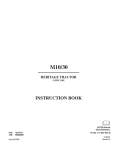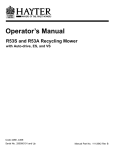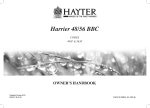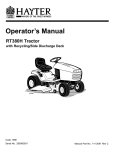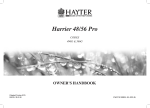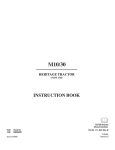Download Hayter Mowers 447F Lawn Mower User Manual
Transcript
Operator ’s Manual R48 Recycling Mower G008079 Code 446F, 447F Serial No. 310000001 and Up Manual Part No. 111-3375 Rev A This product complies with all relevant European directives, for details please see the separate product specific Declaration of Conformity (DOC) sheet. information and Note emphasizes general information worthy of special attention. Contents Introduction Introduction................................................................. 2 Safety ........................................................................... 3 General Lawn Mower Safety ................................. 3 Sound Pressure..................................................... 4 Sound Power ........................................................ 4 Vibration, Hand/arm ........................................... 4 Safety and Instructional Decals ............................. 5 Setup............................................................................ 6 Unfolding the Handle........................................... 6 Filling the Engine with Oil .................................... 6 Installing the Fuse (Model 447F Only)................... 7 Charging the Battery (Model 447F Only) ............... 7 Product Overview ........................................................ 8 Operation..................................................................... 8 Filling the Fuel Tank............................................. 8 Checking the Engine Oil Level.............................. 8 Adjusting the Cutting Height ................................ 9 Starting the Engine............................................... 9 Using the Self-propel Drive .................................. 9 Stopping the Engine ........................................... 10 Recycling the Clippings....................................... 10 Bagging the Clippings......................................... 10 Rear-discharging the Clippings............................ 11 Operating Tips ................................................... 11 Maintenance............................................................... 13 Recommended Maintenance Schedule(s) ................ 13 Premaintenance Procedures.................................... 13 Preparing for Maintenance ................................. 13 Lubrication............................................................. 14 Lubricating the Wheel Gears............................... 14 Engine Maintenance............................................... 14 Replacing the Air Filter ....................................... 14 Changing the Engine Oil .................................... 14 Electrical System Maintenance................................ 15 Charging the Battery (Model 447F Only) ............. 15 Replacing the Fuse (Model 447F Only)................ 15 Drive System Maintenance ..................................... 16 Adjusting the Self-propel Drive........................... 16 Blade Maintenance ................................................. 17 Replacing the Blade ............................................ 17 Cleaning ................................................................. 18 Cleaning the Mower............................................ 18 Storage....................................................................... 18 Preparing the Mower for Storage ........................ 18 Removing the Mower from Storage..................... 18 Thank you for purchasing a Hayter mower. The following pages are designed to help you gain safe and efficient service from your machine This rotary-blade, walk-behind lawn mower is intended to be used by residential homeowners or professional, hired operators. It is designed primarily for cutting grass on well-maintained lawns on residential or commercial properties. It is not designed for cutting brush or for agricultural uses. Read this information carefully to learn how to operate and maintain your product properly and to avoid injury and product damage. You are responsible for operating the product properly and safely. Whenever you need service, genuine parts, or additional information, contact an Authorized Service Dealer and have the model and serial numbers of your product ready. Figure 1 identifies the location of the model and serial numbers on the product. Figure 1 1. Model and serial number plate This manual identifies potential hazards and has safety messages identified by the safety alert symbol (Figure 2), which signals a hazard that may cause serious injury or death if you do not follow the recommended precautions. Figure 2 1. Safety alert symbol This manual uses 2 words to highlight information. Important calls attention to special mechanical © 2009—Hayter Limited 2 Printed in the USA. All Rights Reserved Safety • If petrol is spilled, do not attempt to start the engine but move the mower away from the area of spillage and avoid creating any source of ignition until petrol vapors have dissipated. • Replace all fuel tank and container caps securely. Improperly using or maintaining this mower can result in injury. To reduce the potential for injury, comply with these safety instructions. This mower was designed and tested for reasonably safe service; however, failure to comply with the following instructions may result in personal injury. Preparation General Lawn Mower Safety • While mowing, always wear substantial footwear and long trousers. Do not operate the equipment when barefoot or wearing open sandals. • Thoroughly inspect the area where the equipment is to be used and remove all stones, sticks, wires, bones and other foreign objects. • Before using, always visually inspect to see that guards, and safety devices, such as deflectors and/or grass bags, are in place and working correctly. • Before using, always visually inspect to see that the blades, blade bolts and cutter assembly are not worn or damaged. Replace worn or damaged blades and bolts in sets to preserve balance. The following instructions have been adapted from the ISO 5395. Starting To ensure maximum safety, best performance, and to gain knowledge of the product, it is essential that you and any other operator of the mower read and understand the contents of this manual before the engine is ever started. Pay particular attention to the safety alert symbol (Figure 2) which means Caution, Warning, or Danger—“personal safety instruction.” Read and understand the instruction because it has to do with safety. Failure to comply with the instruction may result in personal injury. • Disengage all blade and drive clutches and shift into neutral before starting the engine. • Do not tilt mower when starting the engine or switching on the motor, unless the mower has to be tilted for starting. In this case, do not tilt it more than absolutely necessary and lift only the part, which is away from the operator. • Start the engine or switch on the motor carefully according to instructions and with feet well away from the blade(s) and not in front of the discharge chute. This cutting machine is capable of amputating hands and feet and throwing objects. Failure to observe the following safety instructions could result in serious injury or death. Training • Read the instructions carefully. Be familiar with the controls and the proper use of the equipment. • Never allow children or people unfamiliar with these instructions to use the mower. Local regulations can restrict the age of the operator. • Keep in mind that the operator or user is responsible for accidents or hazards occurring to other people or their property. • Understand explanations for all pictograms used on the mower or in the instructions. Operation • Never mow while people, especially children, or pets are nearby. • Mow only in daylight or in good artificial light. • Stay alert for holes in the terrain and other hidden hazards. • Do not put hands or feet near or under rotating parts. Keep clear of the discharge opening at all times. • Never pick up or carry a lawn mower while the engine is running. • Use extreme caution when reversing or pulling a pedestrian controlled lawn mower towards you. • Walk, never run. • Slopes: Petrol WARNING-Petrol is highly flammable. Take the following precautions. • Store fuel in containers specifically designed for this purpose. • Refuel outdoors only and do not smoke while refueling. • Add fuel before starting the engine. Never remove the cap of the fuel tank or add petrol while the engine is running or when the engine is hot. 3 • • • • • • • – Do not mow excessively steep slopes. – Exercise extreme caution when on slopes. – Mow across the face of slopes, never up and down and exercise extreme caution when changing direction on slopes. – Always be sure of your footing on slopes. Use low throttle settings when engaging the traction-clutch, especially in high gears. Reduce speed on slopes and in sharp turns to prevent overturning or loss of control. Stop the blade if the lawn mower has to be tilted for transportation when crossing surfaces other than grass and when transporting the lawn mower to and from the area to be mowed. Do not operate the engine in a confined space where dangerous carbon monoxide fumes can collect. Stop the engine – whenever you leave the lawn mower. – before refueling. – before removing the grass bag. – before making height adjustment unless adjustment can be made from the operator’s position. Stop the engine and disconnect the spark-plug lead. – before clearing blockages or unclogging chute. – before checking, cleaning or working on the lawn mower. – after striking a foreign object, inspect the lawn mower for damage and make repairs before restarting and operating the lawn mower. – if lawn mower starts to vibrate abnormally (check immediately). Watch out for traffic when crossing or near roadways. Lightning can cause severe injury or death. If lightning is seen or thunder is heard in the area, do not operate the machine; seek shelter. • To reduce the fire hazard, keep the engine, silencer, battery compartment and petrol storage area free of grass, leaves, or excessive grease. • Check grass bag components and the discharge guard frequently and replace with manufacturer’s recommended parts, when necessary. • Replace worn or damaged parts for safety. • Replace faulty silencers. • If the fuel tank has to be drained, do this outdoors. • Do not change the engine governor settings or overspeed the engine. Operating an engine at excessive speed can increase the hazard of personal injury. • On multibladed lawn mowers, take care as rotating one blade may cause others to rotate. • Be careful during adjustment of the lawn mower to prevent entrapment of the fingers between moving blades and fixed parts of the lawn mower. • To ensure the best performance and safety, purchase only genuine replacement parts and accessories. Do not use will fit parts and accessories; they may cause a safety hazard. Sound Pressure This unit has a sound pressure level at the operator’s ear of 84 dBA, which includes an Uncertainty Value (K) of 1 dBA. Sound pressure level was determined according to the procedures outlined in EN 836. Sound Power This unit has a guaranteed sound power level of 98 dBA, which includes an Uncertainty Value (K) of 1 dBA. Sound power level was determined according to the procedures outlined in ISO 11094. Maintenance and Storage Vibration, Hand/arm • Keep all nuts, bolts and screws tight to be sure the equipment is in safe working condition. • Do not use pressure cleaning equipment on machine. • Never store the equipment with petrol in the tank and inside a building where fumes can reach an open flame or spark. • Allow the engine to cool before storing in any enclosure. Measured vibration level for right hand = 4.9 m/s2 Measured vibration level for left hand = 4.3 m/s2 Uncertainty Value (K) = 2.5 m/s2 Measured values were determined according to the procedures outlined in EN 836. 4 Safety and Instructional Decals Important: Safety and instruction decals are located near areas of potential danger. Replace damaged decals. Manufacturer’s Mark 1. Indicates the blade is identified as a part from the original machine manufacturer. 110-7126 1. Warning—read the Operator’s Manual. 2. Cutting, dismemberment hazard of hand or foot—remove the spark plug lead before performing any maintenance on the machine. 3. Thrown object hazard—keep bystanders a safe distance from the machine. 110-7058 1. Height of cut 110-7059 Model 447F only 1. Read the Operator’s Manual. 2. Remove the fuse box decal. 3. Remove the fuse box cover. 4. Install the fuse. 5. Replace the fuse box cover. 6. Start the engine. 110-7178 1. Height of cut 5 4. Cutting, dismemberment hazard of hand or foot—stay away from moving parts. 5. Thrown object hazard—keep deflector in place. Setup Unfolding the Handle 1. Unlock the handle locks, move the handle sections into the operating position, and lock the handle locks (Figure 3). Figure 5 Filling the Engine with Oil Your mower does not come with oil in the engine. Figure 3 1. Remove the dipstick (Figure 6). 2. Unlock the upper handle locks and rotate the upper handle upward and lock it into a position that is comfortable to you (Figure 4). Figure 4 1. Highest position 2. Middle position Figure 6 3. Lowest position 2. Slowly pour oil into the oil fill tube until the oil level reaches the Full line on the dipstick (Figure 6). Do not overfill. (Max. fill: 0.59 l, type: SAE 30W detergent oil with an API service classification of SF, SG, SH, SJ, SL, or higher.) Note: You can set the upper handle to 1 of 3 handle positions. Line up the mark to one of the 3 marks on the inner side of the upper handle locks (Figure 4). Note: If a handle lever is loose, open the lever, rotate it clockwise 1 or 2 turns to tighten it, then close the lever (Figure 5). 3. Install the dipstick securely. Important: Change the engine oil after the first 5 operating hours; change it yearly thereafter. Refer to Changing the Engine Oil. 6 Installing the Fuse (Model 447F Only) Charging the Battery (Model 447F Only) Your mower comes with a 40-amp fuse that protects the electric starter. Refer to Charging the Battery in the Maintenance section. Important: You cannot start the mower with the electric starter or charge the battery unless you install the fuse. 1. Remove the battery cover and the battery and locate the fuse holder (Figure 7). Figure 7 1. Screw 2. Battery cover 3. Fuse holder 4. Battery 2. Insert the fuse (from the loose parts bag) into the fuse holder (Figure 8). Figure 8 Note: Your mower comes with a fuse in the owner’s packet and another fuse in the battery box. 3. Install the battery and the battery cover. 7 Product Overview Operation 5 6 Filling the Fuel Tank 7 8 9 4 Petrol is extremely flammable and explosive. A fire or explosion from petrol can burn you and others. 10 11 3 • To prevent a static charge from igniting the petrol, place the container and/or mower directly on the ground before filling, not in a vehicle or on an object. 2 1 • Fill the tank outdoors when the engine is cold. Wipe up spills. 12 14 13 G01201 1 • Do not handle petrol when smoking or around an open flame or sparks. Figure 9 Model 447F shown 1. 2. 3. 4. 5. 6. 7. Lower handle lock Grass bag Upper handle lock Recoil start handle Upper handle Blade control bar Electric start (model 447F only) 8. 9. 10. 11. 12. 13. 14. • Store petrol in an approved fuel container, out of the reach of children. Rear door Oil fill/Dipstick (not shown) Fuel tank cap Cutting height lever (2) Spark plug Air filter Recycling/bagging lever Fill the fuel tank with fresh unleaded petrol (Figure 10). Important: To reduce starting problems, add fuel stabilizer to the fuel all season, mixing it with petrol less than 30 days old. Figure 10 Checking the Engine Oil Level Service Interval: Before each use or daily—Check the engine oil level. 1. Remove the dipstick, wipe it clean, and fully install the dipstick (Figure 6). 2. Remove the dipstick and check the oil level (Figure 6). If the oil level is below the Add mark on the dipstick, slowly pour oil into the oil fill tube to raise the oil level to the Full mark on the dipstick. Do not overfill. (Max. fill: 0.59 l, type: SAE 30W 8 Starting the Engine detergent oil with an API service classification of SF, SG, SH, SJ, SL, or higher.) 1. Hold the blade control bar against the handle (Figure 12). 3. Install the dipstick. Adjusting the Cutting Height Adjusting the cutting height may bring you into contact with the moving blade, causing serious injury. Figure 12 • Stop the engine and wait for all moving parts to stop. 2. Pull the recoil starter (Figure 13) or turn the ignition key as shown in Figure 14 (model 447F only). • Do not put your fingers under the housing when adjusting the cutting height. If the engine has been running, the muffler will be hot and can severely burn you. Keep away from the hot muffler. Adjust the cutting height as desired. Set all four wheels to the same height. Figure 13 Note: To raise the mower, move the 2 cutting height levers forward; to lower the mower, move them both rearward (Figure 11). Figure 14 3. If the mower does not start in 1 or 2 pulls (or within 5 seconds using the electric starter), press the primer button 1 or 2 times and try starting it again. Figure 11 Note: If the mower still does not start, contact an Authorized Service Dealer. Using the Self-propel Drive To operate the self-propel drive, simply walk with your hands on the upper handle and your elbows at your 9 sides, and the mower will automatically keep pace with you. Figure 17 1. Recycling mode 2. Bagging mode Figure 15 Bagging the Clippings Stopping the Engine Use the grass bag when you want to collect grass and leaf clippings from the lawn. 1. Release the blade control bar (Figure 16). A worn grass bag could allow small stones and other similar debris to be thrown in the operator’s or bystander’s direction and result in serious personal injury or death to the operator or bystanders. Figure 16 Check the grass bag frequently. If it is damaged, install a new Hayter replacement bag. 2. When the engine stops, remove the ignition key when you leave the mower. Important: When you release the blade control bar, both the engine and blade should stop within 3 seconds. If they do not stop properly, stop using your mower immediately and contact an Authorized Service Dealer. The blade is sharp; contacting the blade can result in serious personal injury. Stop the engine and wait for all moving parts to stop before leaving the operating position. Recycling the Clippings Your mower comes from the factory ready to recycle the grass and leaf clippings back into the lawn. To bag the grass clippings, install the grass bag (refer to Installing the Grass Bag) and move the Recycling/bagging lever to the bagging mode (Figure 17). Note: The grass bag may remain on the mower while you are recycling the clippings. Installing the Grass Bag To recycle the clippings, move the Recycling/bagging lever to the recycling mode (Figure 17). Raise and hold up the rear door, install the bag, and lower the rear door (Figure 18). 10 The blade is sharp; contacting the blade can result in serious personal injury. Stop the engine and wait for all moving parts to stop before leaving the operating position. Operating Tips General Mowing Tips • Clear the area of sticks, stones, wire, branches, and other debris that the blade could hit. • Avoid striking solid objects with the blade. Never deliberately mow over any object. • If the mower strikes an object or starts to vibrate, immediately stop the engine, disconnect the lead from the spark plug, and examine the mower for damage. • For best performance, install a new blade before the cutting season begins. • Replace the blade when necessary with a genuine replacement blade. G008083 Figure 18 Cutting Grass Removing the Grass Bag • Cut only about a third of the grass blade at a time. Do not cut below the 51 mm setting unless the grass is sparse or it is late fall when grass growth begins to slow down. Refer to Adjusting the Cutting Height. • When cutting grass over 15 cm tall, mow at the highest cutting height setting and walk slower; then mow again at a lower setting for the best lawn appearance. If the grass is too long, the mower may plug and cause the engine to stall. • Mow only dry grass or leaves. Wet grass and leaves tend to clump on the yard and can cause the mower to plug or the engine to stall. To remove the bag, reverse the steps above. Rear-discharging the Clippings Use the rear discharge for cutting very tall grass. If the bag is on the mower, remove it (refer to Removing the Grass Bag) before rear-discharging the clippings (Figure 19). The Recycling/bagging lever should be in the bagging mode. Wet grass or leaves can cause serious injury if you slip and contact the blade. Mow only in dry conditions. • Alternate the mowing direction. This helps disperse the clippings over the lawn for even fertilization. • If the finished lawn appearance is unsatisfactory, try one or more of the following: – Replace the blade or have it sharpened. – Walk at a slower pace while mowing. Figure 19 11 – Raise the cutting height on your mower. – Cut the grass more frequently. – Overlap cutting swaths instead of cutting a full swath with each pass. – Set the cutting height on the front wheels one notch lower than the rear wheels. For example, set the front wheels at 60 mm and the rear wheels at 70 mm. Cutting Leaves • After cutting the lawn, ensure that half of the lawn shows through the cut leaf cover. You may need to make more than one pass over the leaves. • If there are more than 13 cm of leaves on the lawn, set the front cutting height one or two notches higher than the rear cutting height. • Slow down your mowing speed if the mower does not cut the leaves finely enough. 12 Maintenance Recommended Maintenance Schedule(s) Maintenance Service Interval Maintenance Procedure After the first 5 hours • Change the engine oil. Before each use or daily • Check the engine oil level. • Ensure that the engine stops within 3 seconds after releasing the blade control bar. • Clean the mower. Every 25 hours • Charge the battery for 24 hours. (Model 447F only) • Replace the blade or have it sharpened (more frequently if the edge dulls quickly). Every 50 hours • Change the engine oil. Every 100 hours • Clean the cooling system (refer to your engine owner’s manual). • Replace the spark plug (refer to your engine owner’s manual). Before storage Yearly • Empty the fuel tank before repairs as directed and before annual storage. • • • • Lubricate the wheel gears. Replace the air filter (more frequently in dusty operating conditions). Check the spark plug (refer to your engine owner’s manual). Refer to your Engine Operator’s Manual for any additional yearly maintenance procedures. Premaintenance Procedures hand fuel pump to remove the fuel. Always tip the mower onto its side with the air filter up. Preparing for Maintenance Tipping the mower may cause the fuel to leak. Petrol is flammable, explosive and can cause personal injury. 1. Stop the engine and wait for all moving parts to stop. 2. Disconnect the spark plug lead from the spark plug (Figure 20) before performing any maintenance procedure. Run the engine dry or remove the petrol with a hand pump; never siphon. Figure 20 3. After performing the maintenance procedure(s), connect the spark plug lead to the spark plug. Important: Before tipping the mower to change the oil or replace the blade, allow the fuel tank to run dry through normal usage. If you must tip the mower prior to running out of fuel, use a 13 Lubrication Engine Maintenance Lubricating the Wheel Gears Replacing the Air Filter Service Interval: Yearly—Lubricate the wheel gears. 1. Remove the wheel bolts on the rear wheels and remove the rear wheels. Service Interval: Yearly—Replace the air filter (more frequently in dusty operating conditions). 2. Apply a lubricating oil to the gear as shown in Figure 21. 1. Perform the pre-maintenance procedures; refer to Preparing for Maintenance. 2. Open the air filter cover and remove the old air filter (Figure 22). Figure 21 3. Install the rear wheels. Figure 22 3. Install a new air filter and the air filter cover. Changing the Engine Oil Service Interval: After the first 5 hours—Change the engine oil. Every 50 hours—Change the engine oil. Run the engine a few minutes before changing the oil to warm it. Warm oil flows better and carries more contaminants. 1. Perform the pre-maintenance procedures; refer to Preparing for Maintenance. 2. Remove the dipstick (Figure 6). 3. Tip the mower onto its side, with the air filter up, to drain the used oil out through the oil fill tube (Figure 23). 14 Electrical System Maintenance Charging the Battery (Model 447F Only) Service Interval: Every 25 hours—Charge the battery for 24 hours. (Model 447F only) Always use the charger in a sheltered area and charge the battery at room temperature (22° C) whenever possible. Figure 23 1. Connect the charger to the mower wire harness located below the ignition key (Figure 24). 4. Slowly pour oil into the oil fill tube until the oil level reaches the Full line on the dipstick (Figure 6). Do not overfill. (Max. fill: 0.59 l, type: SAE 30W detergent oil with an API service classification of SF, SG, SH, SJ, SL, or higher.) 5. Install the dipstick securely. 6. Dispose of the used oil properly at a local recycling center. Figure 24 2. Plug the charger into a wall outlet. Note: When the battery no longer holds a charge dispose of the lead-acid battery. Replacing the Fuse (Model 447F Only) If the battery does not charge or the engine does not run with the electric starter, the fuse may be blown. Replace it with a 40-amp plug-in type fuse. Refer to Installing the Fuse. 15 Drive System Maintenance Adjusting the Self-propel Drive If your mower does not self-propel properly, adjust the self-propel drive cable. 1. Loosen the nut on the cable mount (Figure 25). Figure 27 1. Exposed cable 4. Push the cable jacket upward 3/16 inch (5 mm) (Figure 28). Figure 28 1. Cable mount 2. Cable jacket Figure 25 Note: You can place a ruler against the upper side of the cable mount and measure how far the upper end of the cable jacket moves. 1. Nut on cable mount 2. Pull the upper handle back fully rearward (Figure 26). Note: Moving the cable jacket upward decreases the ground speed; moving the jacket downward increases the ground speed (Figure 29). Figure 26 3. Pull the cable jacket downward until you remove the slack in the exposed cable (Figure 27). Figure 29 1. Cable jacket 5. Tighten the nut firmly. 6. Start the mower and check the adjustment; repeat this procedure if necessary. 16 Blade Maintenance Important: A bolt torqued to 82 N-m is very tight. While holding the blade with a block of wood, put your weight behind the ratchet or wrench and tighten the bolt securely. This bolt is very difficult to overtighten. Replacing the Blade Service Interval: Every 25 hours—Replace the blade or have it sharpened (more frequently if the edge dulls quickly). Important: You will need a torque wrench to install the blade properly. If you do not have a torque wrench or are uncomfortable performing this procedure, contact an Authorized Service Dealer. Examine the blade whenever you run out of petrol. If the blade is damaged or cracked, replace it immediately. If the blade edge is dull or nicked, have it sharpened or replace it. The blade is sharp; contacting the blade can result in serious personal injury. Wear gloves when servicing the blade. 1. Disconnect the spark plug lead from the spark plug. Refer to Preparing for Maintenance. 2. Tip the mower onto its side with the air filter up (Figure 30). Figure 30 3. Remove the blade, saving all mounting hardware. 4. Install the new blade and all mounting hardware. Important: Position the curved ends of the blade to point toward the mower housing. 5. Use a torque wrench to tighten the blade bolt to 82 N-m. 17 Cleaning Storage Cleaning the Mower Store the mower in a cool, clean, dry place. Service Interval: Before each use or daily—Clean the mower. Preparing the Mower for Storage Tipping the mower may cause the fuel to leak from the carburetor or the fuel tank. Petrol is extremely flammable, highly explosive, and under certain condition can cause personal injury or property damage. Petrol vapors can explode. • Do not store petrol more than 30 days. • Do not store the mower in an enclosure near an open flame. Run the engine dry or remove the fuel with a hand pump; never siphon the fuel. • Allow the engine to cool before storing it. 1. Perform the pre-maintenance procedures; refer to Preparing for Maintenance. 1. On the last refueling of the year, add fuel stabilizer to the fuel as directed by the engine manufacturer. 2. Remove the grass bag. 2. Run the mower until the engine stops from running out of fuel. 3. Drain the fuel from the fuel tank. 3. Start the engine. 4. Tip the mower onto its side with the air filter up. 4. Allow the engine to run until it stops. When you can no longer start the engine, it is sufficiently dry. 5. Remove the dirt and grass clippings with a hardwood or plastic scraper. Avoid burrs and sharp edges. 5. Disconnect the lead from the spark plug. 6. Spray the underside of the mower housing with water. 6. Remove the spark plug, add 30 ml of oil through the spark plug hole, and pull the starter rope slowly several times to distribute oil throughout the cylinder to prevent cylinder corrosion during the off-season. 7. Turn the mower upright after cleaning the mower. 7. Loosely install the spark plug. 8. Tighten all nuts, bolts, and screws. 9. Charge the battery for 24 hours (model 447F), then unplug the battery charger and store the mower in an unheated area. If you must store the mower in a heated area, charge the battery every 90 days. Removing the Mower from Storage 1. Remove the spark plug and spin the engine rapidly using the starter to blow the excess oil from the cylinder. 2. Install the spark plug and tighten it with a torque wrench to 20 N-m. 3. Charge the battery for 24 hours (model 447F only). 4. Connect the lead to the spark plug. 18 Notes: 19 Notes: 20 1st Year (12 months) We certify that this service has been carried out by an Authorised Hayter Service Dealer Date: 1st Year (12 months) Owner’s Name: Serial Number: Date: Note for dealer: Please retain this voucher for your records. 2nd Year (24 months) We certify that this service has been carried out by an Authorised Hayter Service Dealer Date: 2nd Year (24 months) Owner’s Name: Serial Number: Date: Note for dealer: Please retain this voucher for your records. LIMITED WARRANTY Hayter Limited warrants to the original user/purchaser that this unit shall be free from defects in material and workmanship under normal use and service for a period of three years from the date of purchase. The manufacturer of major proprietry components ie. engines, gearbox / transaxle (where applicable) furnish their own warranty and services are provided through their authorised network. To qualify for the full benefit of the warranty, the warranty registration card must be returned within 14 days of purchase. Subject to the conditions and exclusions noted in this limited warranty, we shall at our option, repair or replace any warranted part during the applicable period. If you are in doubt or experience any difficulty, please consult a Hayter Authorised Service Dealer for clarification. To qualify for the extended warranty (second and third year) of the three year limited warranty the machine must have annual services carried out by an Authorised Hayter Service Dealer. These chargeable services should be carried out within 12 and 24 months of the date of purchase. Excluded from the extended warranty period are those items which are subject to normal wear and tear e.g. tyres, wheels, cutterblades, belts, cables, grassbags, brush/bristles, batteries and other consumable wearing parts. All consumer machines which are fitted with a genuine Hayter friction disc as original equipment before use, are covered by a Lifetime Warranty against the engine crankshaft bending. Note: friction washers, blade brake clutch (B.B.C) units and other such devices are not applicable. Only machines fitted with a genuine Hayter friction disc, which are used in accordance with the recommended operating and maintenance procedures, are covered. This warranty does not apply to any unit that has been tampered with, altered, misused, abused or used for hire, and will become invalid if non genuine Hayter parts are fitted. This warranty does not cover minor mechanical adjustments unless they are due to defective material or workmanship. Consult the Owner's Handbook or a Hayter Authorised Service Dealer for assistance when making these adjustments. A warranty period of 90 days applies to machines used for commercial purposes. This limited warranty gives you specific legal rights and is in addition to any statutory rights to which you may be entitled and your statutory rights are not affected by this warranty. If you need additional information concerning this written warranty, or assistance in obtaining services, please write to : HAYTER LIMITED, Service Department, Spellbrook, Bishop's Stortford, Hertfordshire CM23 4BU UK ONLY: Details of your local Hayter authorised dealer are contained in Yellow Pages and the Hayter website www.hayter.co.uk or contact:- Freephone 0800 616298. Issue: 12.08.03 To make a warranty claim, return the unit to a Hayter authorised dealer along with proof of purchase stating the machine serial number and date of purchase. The service receipt(s) or this Owners Handbook with the 1st/2nd year service boxes fully completed, must be produced as proof of entitlement to the extended warranty period. Subject to the conditions and exclusions in this limited warranty, the authorised dealer will, at our option, repair or replace any warranted part within the duration of the warranty period. CUS TOMER INFORMATION Code Serial No. Date of Sale:Your Local Dealer:- HAYTER L IMITED,SPELLBROOK,BISHOP’S STORTFORD, HERTS. CM23 4BU, ENGLAND

























